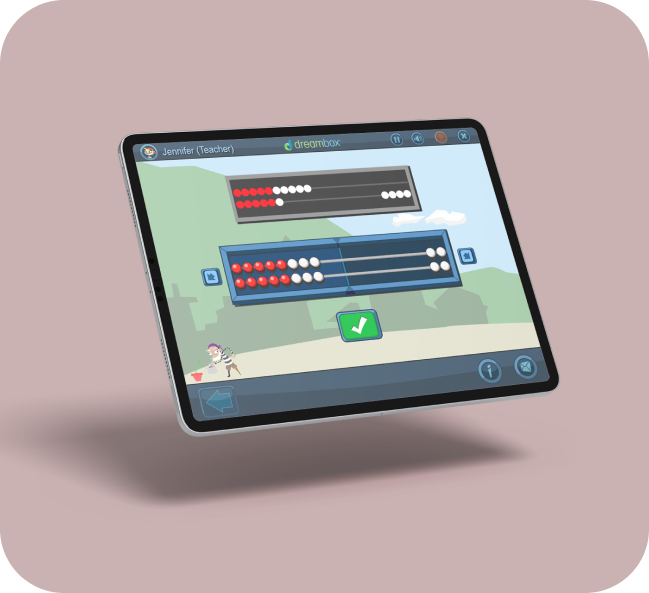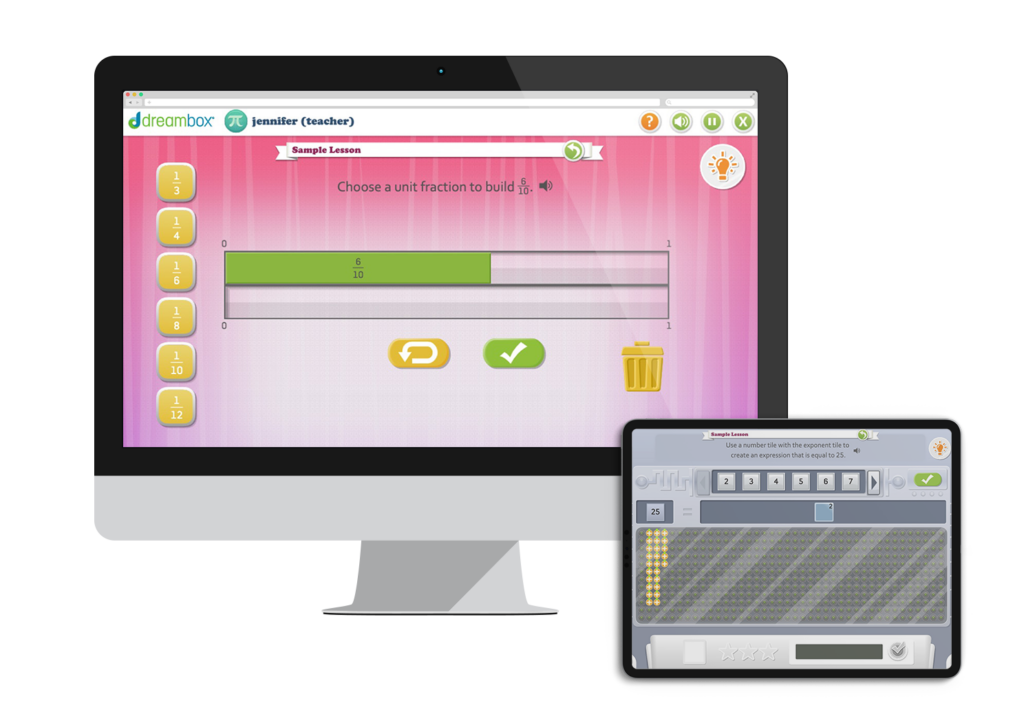
Engaging first grade math
that inspires learning
Help your first grader develop essential math skills through interactive games and a proven curriculum
Mastering first grade math concepts is critical for building a solid foundation. DreamBox Math uses engaging challenges and interactive exercises to help your child build confidence in their math skills without even realizing they’re learning.
Engaging First Grade Math That Inspires Learning
Help your first grader develop essential math skills through interactive games and a proven curriculum
Mastering first grade math concepts is critical for building a solid foundation. DreamBox Math uses engaging challenges and interactive exercises to help your child build confidence in their math skills without even realizing they’re learning.
First grade curriculum alignment
First grade math builds on kindergarten concepts like counting and patterns while introducing new topics such as addition, subtraction and place value.
By the end of the school year, your first grader should feel confident with these key math concepts:
- Addition and Subtraction: Solve simple math problems up to 20.
- Counting and Place Value: Understand numbers up to 120 and learn how they fit together.
- Shapes and Geometry: Recognize and describe 2D and 3D shapes.
- Time and Measurement: Practice telling time and comparing lengths.
- Patterns and Problem-Solving: Spot and create patterns, and tackle simple math problems.
Our first grade online math practice tool and resources are aligned with educational math standards. First grade math concepts covered include:
- Counting
- Build to 20 Optimally
- Build to 50 Optimally
- Build to 100 Optimally
- Comparisons & Ordering
- Identify More & Less Up to 100
- Counting Forward & Backward
- Build Columns of a 100s Chart
- Moving on a 100s Chart
- Comparison Symbols
- Patterning with Shapes
- Rounding to the Nearest Ten (Numbers to 100)
- Addition & Subtraction
- Doubling & Making 10
- Doubling to 20
- Using 10 as a Landmark
- Identifying Number Pairs
- Patterning with Numbers
- Place Value
- Place Value to 100
- Measurement
- Building Pictographs
- Using Clocks & Telling Time III
- Measuring Objects with Various Abstract Tools
- Geometry
- Partitioning Circles and Rectangles with halves and fourths

Personalized for every child
STUDENT-CENTERED LEARNING
Each student learns differently, and DreamBox adapts in real-time to their individual needs. Whether your first grader is soaring ahead or needs extra support, DreamBox adjusts lessons to match their pace and ensure steady progress.
Easy, no hassle setup
NO CREDIT CARD REQUIRED
Trying DreamBox is easy and free! Sign up for a 14-day trial without needing a credit card, and explore the tools and resources designed to help your child thrive.


Concept targeting
CUSTOM ASSIGNMENTS
Is your first grader excelling in addition but needs support in geometry? DreamBox’s assignment tool lets subscribers review progress and assign lessons that target specific areas as needed. You can also customize lessons to strengthen specific skills.
Start your free trial
See how DreamBox can help your first grader with math by signing up for a free trial today.
No credit card required!
Parents and teachers love DreamBox
Benefits of DreamBox for first grade math
Nearly half of first graders in the US are falling behind in math (CRPE). DreamBox can help students get back on track—and have fun doing it. Plus, it provides valuable progress insights for parents and teachers.
Adaptive Learning
DreamBox collects data as first graders play lessons and adapts to the right level, personalizing the lesson pathway.
Proven Results
DreamBox delivers results you can see. Kids who spend just 30–60 minutes per week with DreamBox show an average of 1.5 grade levels of growth by the end of the school year.
Demonstrated Results
DreamBox Learning is the only dual-discipline program rated STRONG by Evidence for ESSA. DreamBox programs have demonstrated efficacy across every achievement level, in every learning environment.
Student-Centered Design
DreamBox Math keeps first-grade students engaged with interactive games, likeable characters, exciting challenges, and more.
Daily Assessment
Student progress is assessed continuously, eliminating the need for one-time placement tests. You’ll also gain an end-to-end view of your first grader’s progress, performance, and trends.
Productive Screen Time
With fun lessons your first grader will look forward to doing, you don’t have to feel guilty about screen time!
Adaptive Learning
DreamBox collects data as first graders play lessons and adapts to the right level, personalizing the lesson pathway.
Proven Results
DreamBox delivers results you can see. Kids who spend just 30–60 minutes per week with DreamBox show an average of 1.5 grade levels of growth by the end of the school year.
Demonstrated Results
DreamBox Learning is the only dual-discipline program rated STRONG by Evidence for ESSA. DreamBox programs have demonstrated efficacy across every achievement level, in every learning environment.
Student-Centered Design
DreamBox Math keeps first-grade students engaged with interactive games, likeable characters, exciting challenges, and more.
Daily Assessment
Student progress is assessed continuously, eliminating the need for one-time placement tests. You’ll also gain an end-to-end view of your first grader’s progress, performance, and trends.
Productive Screen Time
With fun lessons your first grader will look forward to doing, you don’t have to feel guilty about screen time!
Student-centered design
DreamBox Math keeps first-grade students engaged with interactive games, likeable characters, exciting challenges, and more.
Daily assessment
Student progress is assessed continuously, eliminating the need for one-time placement tests. You’ll also gain an end-to-end view of your first grader’s progress, performance, and trends.
Productive screen time
With fun lessons your first grader will look forward to doing, you don’t have to feel guilty about screen time!
Adaptive learning
DreamBox collects data as first graders play lessons and adapts to the right level, personalizing the lesson pathway.
Proven results
DreamBox delivers results you can see. Kids who spend just 30–60 minutes per week with DreamBox show an average of 1.5 grade levels of growth by the end of the school year.
Demonstrated results
Easy access anytime, anywhere
DreamBox is available on computers, laptops, and iPads through an internet browser and via our iPad app. Whether at home, in the car, or at the park, your first grader can keep practicing math wherever they are. At this time, DreamBox Math is not available on smartphones, Android tablets, or eReaders.

FAQs
Yes! DreamBox offers multiple grade levels and family plan options to make it easier than ever to support your child’s math learning.
DreamBox Math supports first graders by observing how they work through problems during each lesson. It tailors activities to their unique learning style and needs, ensuring they’re always challenged at the right level for them. As your child learns and explores, DreamBox tracks their progress and adapts lessons to help them grow. This personalized approach creates a learning experience that’s customized just for them!
You can help your first grader thrive with DreamBox by setting fun and achievable learning goals together! Kids love tracking their progress on DreamBox, which keeps them motivated and excited. Start with small goals, like “Let’s complete 5 lessons this week,” and working up to bigger ones, like “I’ll master these new math skills this month!”
Celebrating their hard work and successes to keeps their confidence growing. If math feels challenging, encourage them to keep trying and talk about what they’re learning. Simple questions like “What did you work on in math today?” can lead to meaningful conversations and show your support.
Use the DreamBox Family Dashboard to see their progress and accomplishments. You can even download certificates to celebrate milestones and make their achievements feel extra special!
No, there’s no credit card required to start a free trial with DreamBox.
First grade resources
Practice important 1st grade math skills like addition, subtraction, measurement, shapes, fractions and more with our games, worksheets, and fun-filled guides. Follow along with classroom activities or scaffold your learning and build a path from least advanced to more advanced topics to become the ultimate math wiz kid!
Discover how to prepare your child for the first day of first grade with tips on routines, emotions, and learning support.
Discover fun and effective ways to teach 1st grade addition word problems. Includes examples, strategies, and tips for parents and teachers.
Let’s explore your options for first grade homeschool curriculum. (Hint: it should be simple, fun, and affordable!)
Get your child ready for 1st grade with this complete 2025–2026 school supply list, including essentials, extras, and classroom tips!
What should a first grader know? This readiness guide will help your child prepare for a new year!
Discover fun and effective ways to teach 1st-grade subtraction word problems, including 20 practice questions and answers.
First grade math skills to practice
The world around us is made up of so many different shapes. Help your child identify them and describe their properties too!
Addition is a basic, but important skill, that children must learn before they can move on. Discover how to add two numbers together to find the sum.
Use a hundred chart to help students move from concrete math manipulatives to actual place values.
Time is told using the numbers on a digital clock or the hands on an analog clock using hours, minutes, and seconds. Learning to read a clock is crucial to staying on track in your daily life!
Finding the difference between two numbers is a fantastic foundational skill. Let’s help your child master it before moving on to trickier concepts.
Discover different types of ruler, how to read measurements on a ruler in inches and centimeters, and how to apply these skills to real-world problems.
Although odd and even numbers are explored in more detail in second grade, it’s always good to get a head start!
Learn all about numbers above zero, their properties and have a go at some practice problems.
Learn all about numbers below zero, their properties and have a go at some practice problems.
Number lines are a great visual representation of sequential numbers. See how they can be used to support mental math skills and solve mathematical operations.
Math doesn’t have to be scary! With a little creativity and a confidence boost, math can be an enjoyable experience for the whole family.
Find other grades
If you’ve ever wondered how to help your child with math homework or what they should know by the end of fifth grade, these elementary math resources are for you.
Choose a grade level below to browse math skills and objectives by grade.
It’s time to build on what we’ve learnt so far and develop mathematical fluency.
Level up number knowledge with the introduction of multiplication, division and fractions.
Classifying, analysing and problem-solving: we’re applying all our skills here!
Understanding is extended even further across number, measurement and geometry.
Meet ratio, rational numbers and equations – this is where we explore statistical thinking.
Children learn more advanced topics like pre-algebra and investigate complex statistics and probability.
Introduce problems involving shape, scale drawings, population samples and more.










